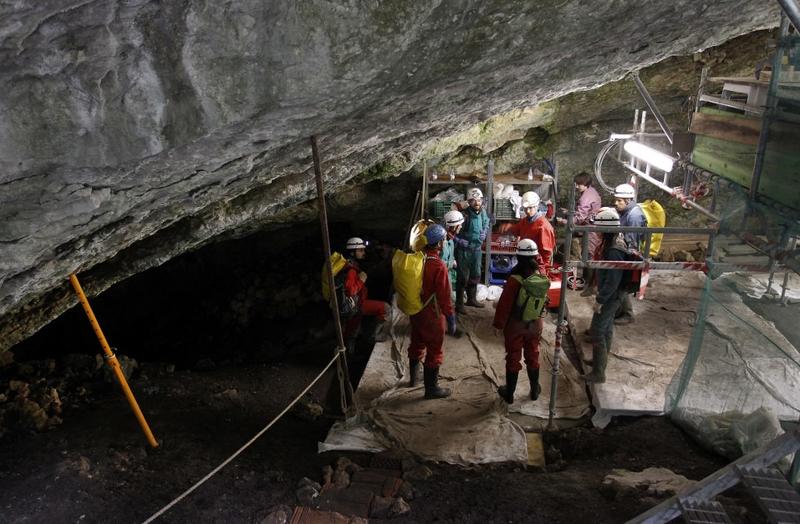 Workers carrying out an excavation at the Atapuerca archaeological site, participating in the '2010 season' of digging, prepare to go down to the "Sima de los Huesos" on July 21, 2010. (CESAR MANSO / AFP)
Workers carrying out an excavation at the Atapuerca archaeological site, participating in the '2010 season' of digging, prepare to go down to the "Sima de los Huesos" on July 21, 2010. (CESAR MANSO / AFP)
Bones recovered from one of the world's most significant fossil sites have started a debate over whether some of the earliest human ancestors may have hibernated to survive harsh winters.
The site at Atapuerca, in northern Spain, is known as the Sima de los Huesos, or Pit of Bones. Since the early 1980s, thousands of teeth and bones, some dating back more than 400,000 years, have been found. They are thought to belong to early Neanderthals or even their predecessors.
Since the early 1980s, thousands of teeth and bones, some dating back more than 400,000 years, have been found. They are thought to belong to early Neanderthals or even their predecessors
Marks on the bones are similar to those found on the bones of animals that hibernate, raising the question whether early humans had a way of slowing down their metabolisms to survive the winter in similar fashion.
READ MORE: Mom was Neanderthal: Fossil shows mix of humankind's cousins
The site has long been regarded as one of the world's most important digging sites.
The new findings, published in the journal L'Anthropologie by original excavation leader Juan-Luis Arsuaga, and Antonis Bartsiokas, of Democritus University of Thrace in Greece, have opened up a fresh debate with the suggestion that bone growth seemed to be disrupted for periods each year.
The authors admit their ideas "may sound like science fiction" but say the signs indicate that these early humans could have been "in metabolic states that helped them to survive for long periods of time in frigid conditions with limited supplies of food and enough stores of body fat".
Atapuerca is one of Europe's most important archaeological sites. Earlier this year, the discovery of two sharp stones dating back 600,000 years completed a chain proving uninterrupted human presence there dating back 1.4 million years.
ALSO READ: Traces of Denisovans discovered on Qinghai-Tibet Plateau
Completing the puzzle
"Thanks to this discovery, Atapuerca is the only site that can tell the entire history of human evolution in Europe with all of its human species," paleoanthropologist Maria Martinon-Torres, from the National Research Center on Human Evolution, told Spanish newspaper El Pais.
"These are precisely the pieces we needed to complete the puzzle."
The suggestion of human hibernation has certainly roused interest in the anthropological community, even if people have not yet been convinced by it.
"It is a very interesting argument and it will certainly stimulate debate," forensic anthropologist Patrick Randolph-Quinney of Northumbria University told The Guardian.
"However, there are other explanations for the variations seen in the bones found in Sima and these have to be addressed fully before we can come to any realistic conclusions. That has not been done yet, I believe."
One counter-argument is that if humans have previously hibernated, why do modern day communities living in extreme conditions, such as the Inuit or Sami people, not do the same.
The authors say the high levels of fat provided by fish and reindeer meat in their diet allow them to function normally in winter, so it is unnecessary, unlike the conditions in which people lived in Atapuerca.
"The aridification of Iberia then could not have provided enough fat-rich food for the people of Sima during the harsh winter-making them resort to cave hibernation," they wrote.


